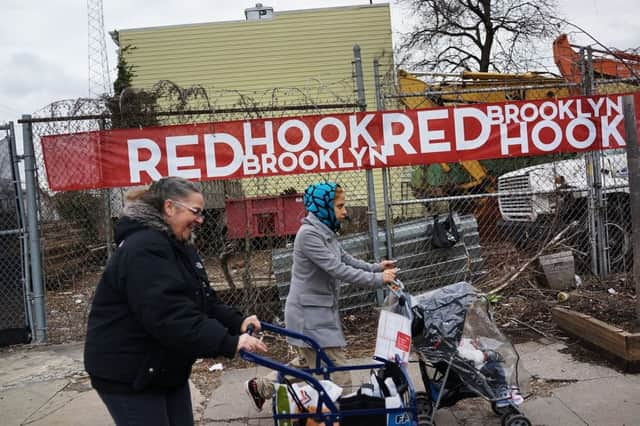Agenda: '˜Going to jail is an accelerant of misery.'


A much-loved and respected elementary school principal, his death had the power to shock a community which had otherwise become inured to violence.
More than 25 years on, Red Hook stands transformed. An area once considered a no-go zone is now a hipster neighbourhood full of bars and restaurants.
Advertisement
Hide AdAdvertisement
Hide AdThe Red Hook of the early 1990s was a different place entirely: less than ten miles from Midtown Manhattan, it might as well have been in another country.
Red Hook Houses, the vast public housing project where many local residents live to this day, had been painted as the ground zero of America’s crack epidemic in an influential 1988 Life magazine article.
It took the shocking murder of Mr Daly – his death reported on the front page of the New York Times – for things to change.
The Red Hook Community Justice Centre, the first multi-jurisdictional community court in the United States, sought to break a seemingly never-ending circle of offending and incarceration.
Advertisement
Hide AdAdvertisement
Hide AdInstead of sending defendants to jail, its disposals include community service and long-term drug and alcohol treatments.
Greg Berman, director of the Centre for Court Innovation, which runs the project, was in Scotland recently speaking to Holyrood’s justice committee.
Scottish interest began in the early 2000s when Elish Angiolini, a future lord advocate, visited Red Hook to see the progress being made.
“The Red Hook Community Justice Centre emerged out of a real sense of crisis in the neighbourhood,” Mr Berman says.
Advertisement
Hide AdAdvertisement
Hide Ad“It was the shooting of Patrick Daly which really focussed political will and public interest.
“Red Hook was an area very few New Yorkers would ever go to – it’s surrounded on three sides by water and cut off from the rest of Brooklyn by an elevated highway. Even more importantly, it’s one of the very few neighbourhoods in New York which doesn’t have its own subway stop.”
Independent evaluation of the Red Hook Community Justice Centre shows it has significantly reduced the use of incarceration, help tackle recidivism and, perhaps most importantly, increase trust in the justice system.
“Red Hook is dramatically different from when we moved in,” Mr Berman says. “There are a whole host of factors connected to that, but our belief is that economic development rarely happens in an area where people feel unsafe.
Advertisement
Hide AdAdvertisement
Hide Ad“The reality was that Red Hook was an unsafe neighbourhood and it’s been radically transformed in that regard. We’ve been part of that story.”
Scotland has its own problems with a stubbornly high prison population, despite the introduction of Community Payback Orders, Drug Treatment and Testing Orders and a presumption against short sentences.
There were just over 7,800 people behind bars in Scotland last month, the highest figure recorded since August 2014.
Mr Berman believes the experience of the United States – where the prison population is among the highest in the world – shows community justice can be far more effective than simply continuing to send people to jail. “We believe that crime should have consequences; we’re not abolitionists or people who think you should have a Get out of Jail Free card,” he says.
Advertisement
Hide AdAdvertisement
Hide Ad“But what we find in the States is that going to jail is an accelerant of human misery. Any problem that you have going into jail – a bad marriage, a health problem, a problem with drink or drugs – is worse when you come out.
“There should be punishment for misbehaviour, but it should be meaningful and productive. These alternatives are more meaningful for the offender but also for the community around them that wants to see the behaviour stopped.”
During his recent trip to Scotland, Mr Berman was a guest of Karyn McCluskey, the head of Community Justice Scotland who helped set up Glasgow’s hugely influential Violence Reduction Unit, the first police initiative anywhere in the world to treat violence as a public health issue.
Born out of frustration at the failure to tackle the city’s knife crime culture, the VRU was partly inspired by an anti-gang initiative first piloted on the streets of Boston in the 1990s.
Advertisement
Hide AdAdvertisement
Hide AdSince its creation in 2005, it has been credited with helping to radically reduce the amount of violence on the streets of Scotland’s largest city, with official statistics showing a 60 per cent fall in homicides over the past decade.
There is now a growing interest in doing something similarly radical to help drive down the prison population and reduce re-offending.
Mr Berman admits to being impressed by the “palpable spirit of innovation” in Scotland, something he feels is currently lacking in the English criminal justice system.
And he believes controversial forms of restorative justice, where a victim meets an offender face to face or receives a written apology can work.
Advertisement
Hide AdAdvertisement
Hide Ad“There’s a sea change under way in terms of how people think about criminal justice that’s about understanding the underlying problems which drive criminal behaviour,” he says.
“It’s about trying to tie crime to its consequences. We’re trying to encourage a sense of accountability, not in a punitive way, but a restorative justice way.
“If you have harmed the community, you should pay back the community because you’re going to be part of this community over the long-haul.
“There’s a very tiresome tough on crime / soft on crime dynamic. It’s about changing the conservation to effective justice that works.”